- Travel to Sado Island Model Course Guide
- Visit in the footsteps of Nichiren
Visit in Nichiren's Footsteps
-
Departure

Namidaimoku Monument (literally means wave mantra) stands in the shore of Maura, where Nichiren Shonin, founder of Nichiren School of Buddhism exiled to Sado, departed from Sado after pardoned by the Kamakura Shogunate. According to the lore in the area, when Nichiren put his palms together and prayed to the sun aboard a boat offshore, seven letters of Namu Myoho Renge Kyo (南無妙法蓮華経) appeared in the waves. Closely related to Nichiren Shonin, the Maura area has many legends, and is dotted with sacred places including Nichirendo Hall, Nichiren Cave, etc.
-
Approximately 21 minutes by carDestination B
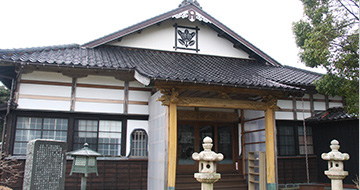
Matsugasaki is said to be the place where Nichiren Shonin arrived on Sado. Hongyoji Temple was established by Futsujubo Nichiryo (Buddhist monk who was a strong believer of Nichiren) to commemorate the Nichiren's first step on Sado. Within the grounds, you can see the stone statue of preaching Nichiren Shonin, and a large tree of Japanese zelkova (kayak in Japanese) called "Okeyaki", under which Nichiren kept the night dew out after landing on Sado.
-
Approximately 33 minutes by carDestination C
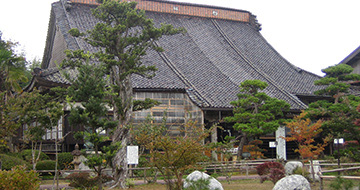
The Sanmaido Hall within the grounds of Konponji Temple is reputed to be the place where Nichiren (a Buddhist monk and the founder of the Nichiren School) had a debate with monks from other schools, and authored Kaimokusho (The Opening of the Eyes). It is one of the sacred places for the Nichiren school, along with Myoshoji Temple in the Sawata area, where Nichiren wrote Kanjinhonzonsho (The Object of Devotion for Observing the Mind). Konponji Temple is a temple complex consisting of twenty-nine buildings and halls on an area of approximately 56,200 square metres. Included on the grounds are Soshido Hall (named after its founder) and the Main Hall, constructed and donated by wealthy gold-mining engineers in the Edo Period (1603-1867).
-
Approximately 11 minutes by carDestination D
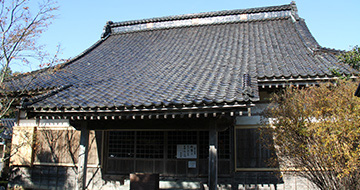
Founded by Nichiro Shonin and his disciple Nichigyo Shonin. There are many historic sites within the temple grounds, including the pardon stone on which Nichiren Shonin sat when he presented the letter of pardon brought from Kamakura by his disciple Nichiro Shonin, and the kesa-kake-no-Matsu (pine tree) on which he hung his kesa (priest's robe).
-
Approximately 6 minutes by carDestination E
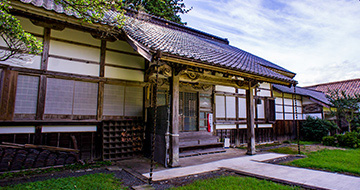
Sesonji Temple houses a lovely green garden on its ancient grounds. Six temple buildings, including the main hall, are designated as Japan's Tangible Cultural Properties. Morikuni Endo, who was a member of Emperor Juntoku's troop and accompanied to Sado along with Emperor Juntoku, encountered Nichiren (founder of Nichiren School of Buddhism, exiled to Sado) and became a fervent follower of him. Sesonji Temple is a meditation hall established with Nikko, a leading disciple of Nichiren, as the head of the temple. The temple houses a mandala drawn by Nichiren Shonin, and also a drawing of Daikokuten (god of wealth) which Nichiren drew at the beach of Shibute (Mano) at the time of his departure from Sado after being pardoned. Mahori Hogan Yoshitaka, a master painter, donated a painting entitled Shibuya Daikokuten. Sesonji Temple is one of the temples on Sado's Seven Gods of Fortune pilgrimage route. Sesonji Temple is also known for its beautiful azalea.
-
Approximately 1 minute by carDestination F
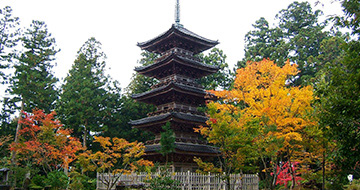
Tamemori Endo (Abutsubo Nittoku Shonin) served Nichiren upon being exiled to Sado and became an avid believer of the Hokke mantra. Together with his wife, Sen-nichini (a Buddhist nun), he opened his residence as a temple in 1278, and this is said to be the origin of Myosenji Temple. The temple used to be a residence of the Takeda Honma clan, deputy governor of Sado, and the ambience of a castle still remains. On site stands the only five-story pagoda in Niigata Prefecture, as well as the grave of Suketomo Hino, who was forced into exile on Sado after the Shochu Incident.
-
About 12 minutes by carDestination G
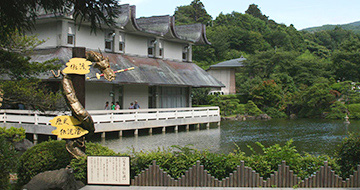
Full-size robots intriguingly tell of the history and legends of Sado. On the first floor, famous scenes with historical significance are introduced by robots in elaborate clothing which are exact replicas of historical figures. Witness Emperor Juntoku mourning his fate with the moon at the place of his exile, or a famous Tsukahara debate between Nichiren and other priests from other schools, and Zeami (14th-15th-century Noh actor and playwright) dancing to pray for rains. On the second floor, photographs and art objects inspired by Sado's ambiance are on exhibit. Shodo Sasaki Museum is located within the museum, where the works of lost-wax casting by Shodo Sasaki, a living national treasure, are on display. You may also enjoy the taste of Sado at a restaurant on site.
-
Approximately 20 minutes by carDestination H
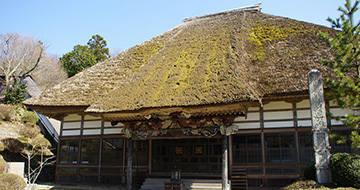
Myoshoji Temple is where Nichiren Shonin, founder of Nichiren School exiled to Sado, resided in a hermitage. He moved to here from Sanmaido in Tsukahara, where he authored Kaimokusho ("The Opening of the Eyes"), and spent about two years until he was pardoned in 1274. Nichiren perfected the doctrine of Nichiren School by authoring Kanjinhonzonsho ("The Object of Devotion for Observing the Mind") and revealing the main object of worship, the Hokke Mandala (Lotus Mandala) in Myoshoji Temple, and that makes Myoshoji Temple a sacred place for Nichiren School. Myoshoji Temple is also known as a temple named by Nichiren Shonin himself, and there is Soshido Hall dedicated to Nichiren on the old site of his hermitage.
-
Approximately 35 minutes by carGoal!
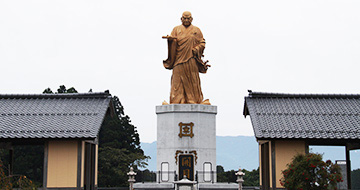
This bronze statue of Nichiren (founder of the Nichiren School of Buddhism and an exile to Sado) was erected as a result of the concerted contribution of over 3,000 monks and followers all around Japan, and as a part of a celebration for the 750th anniversary since the establishment of the Nichiren School. With Ryotsu Bay as its backdrop, the statue stands facing India, the Buddha's birthplace, at approximately 13 metres high (26 metres including the base). The statue appears with a great dignity well-suited to Sado, which is closely related to Nichiren.